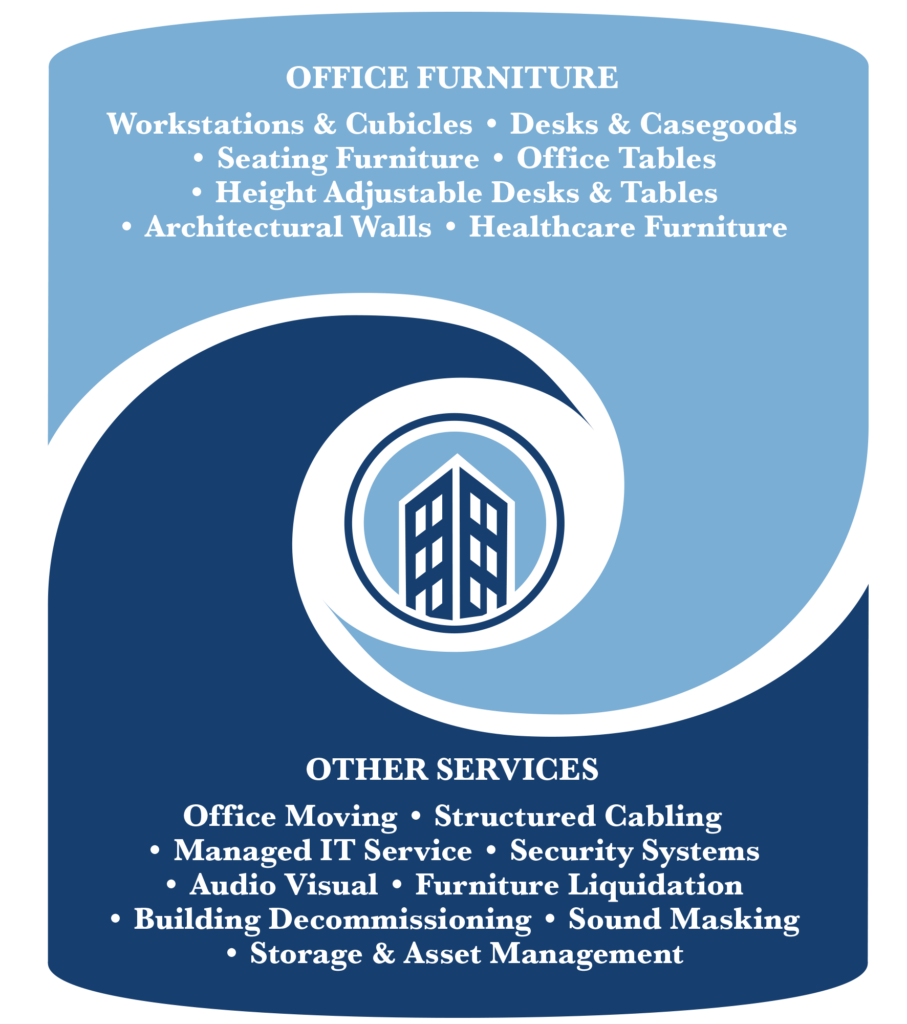20 Sep Smoothly Transitioning-Key Considerations for Office Decommissioning and Moving Out
Office decommissioning is the process of vacating a building facility. It involves the careful and strategic removal of office equipment, furniture, and supplies, as well as the disconnection of utilities and termination of lease agreements. Office decommissioning is a significant undertaking that requires meticulous planning and execution to ensure a smooth transition for both the employees and the organization as a whole.

Planning for Office Decommissioning
 Planning is crucial when it comes to office decommissioning. It is essential to start the process well in advance of a required “exit by” date to allow ample time for all necessary preparations. The first step is to assess the current office space and figure out the scope of the decommissioning project. This includes identifying the furniture, equipment, and supplies that will be moved, sold, or disposed of. It is also important to decide on a timeline for the decommissioning process, considering any potential disruptions to the business operations.
Planning is crucial when it comes to office decommissioning. It is essential to start the process well in advance of a required “exit by” date to allow ample time for all necessary preparations. The first step is to assess the current office space and figure out the scope of the decommissioning project. This includes identifying the furniture, equipment, and supplies that will be moved, sold, or disposed of. It is also important to decide on a timeline for the decommissioning process, considering any potential disruptions to the business operations.
Another key aspect of planning is to set up a budget for the office decommissioning project. This will help distribute resources appropriately and ensure that all necessary tasks can be completed within the set timeframe. It is important to consider costs such as packing materials, transportation, storage, and hiring professional decommissioning services if needed. By having a well-thought-out plan in place, organizations can minimize the risk of delays, extra expenses, and other potential issues that may arise during the decommissioning process.
Key Considerations for Office Decommissioning
 There are several important considerations to keep in mind when undertaking office decommissioning. First and foremost, it is crucial to have a clear communication plan in place to inform employees, clients, and other stakeholders about the upcoming changes. This includes providing them with regular updates, answering any questions or concerns they may have, and ensuring that they are well-informed throughout the entire process.
There are several important considerations to keep in mind when undertaking office decommissioning. First and foremost, it is crucial to have a clear communication plan in place to inform employees, clients, and other stakeholders about the upcoming changes. This includes providing them with regular updates, answering any questions or concerns they may have, and ensuring that they are well-informed throughout the entire process.
Lease Requirements
Often, this process is predicated by factors that are outside of the control of the business. While this can be a challenging time for the owners, managers, and employees of the business, it is important to remember that the entity still has obligations to meet. A primary consideration is the lease for the location in question. It is important to fully review the lease to understand your responsibilities as the tenant/lessee. You must ensure that all the obligations of leaving the space as defined in the lease are met. This may include provisions to restore the space to a certain condition. You may only be obligated to leave the space “broom clean.” Or more complex scenarios may apply like:
1) removing specific tenant improvements (Tis) that you may have initially implemented at move-in;
2) safe-off electrical/gas/water outlets and removal of all data cabling.
These requirements can affect the budget and timeline of your decommissioning plan. It is important to remember that the lease likely offers the lessor specific cures for your non-performance. That said, it’s important to seek to leave the premises on amicable terms and if there are issues, open communication with the landlord can often prevent issues from manifesting in the first place.
Data Security
Another key consideration is data security and privacy. Organizations must take steps to ensure that all sensitive information is properly secured and protected during the decommissioning process. This includes securely disposing of physical documents and equipment, as well as implementing data wiping or destruction protocols for digital files. By prioritizing data security, organizations can safeguard their confidential information. This includes the information of their clients and protect the business from potential breaches or legal issues.
Enviromental Impact
Additionally, organizations should consider the environmental impact of office decommissioning. This includes responsibly disposing of electronic waste, recycling as much material as possible, and minimizing the overall carbon footprint of the decommissioning process. By adopting sustainable practices, organizations can contribute to a greener future and enhance their reputation as socially responsible entities.
The Office Decommissioning Process
The office decommissioning process typically involves several stages. First, create an inventory of all the assets to be moved, sold, or disposed of. This includes furniture, equipment, supplies, and any other items that are part of the office space. Once the inventory is complete, organizations can determine the best course of action for each asset, whether it’s donating, recycling, selling, or relocating.
 Next, organizations need to coordinate the disconnection of utilities and services. This includes notifying service providers, such as electricity, water, and internet companies, about the upcoming relocation or closure. It is important to ensure that all outstanding bills are settled and that the services are properly stopped to avoid any unnecessary expenses or complications.
Next, organizations need to coordinate the disconnection of utilities and services. This includes notifying service providers, such as electricity, water, and internet companies, about the upcoming relocation or closure. It is important to ensure that all outstanding bills are settled and that the services are properly stopped to avoid any unnecessary expenses or complications.
After the utilities are scheduled for disconnection, the actual physical move-out process can begin. This involves packing and labeling all items, ensuring that fragile or sensitive equipment is properly protected, and organizing transportation logistics. It may be necessary to hire professional movers or rent specialized equipment to safely transport large or heavy items. Once everything is packed and ready to go, organizations can proceed with the move-out, carefully following the established timeline and minimizing disruptions to the business operations.
Moving Out Logistics
Moving out logistics play a crucial role in ensuring a smooth office decommissioning process. It is important to have a detailed plan in place for packing, labeling, and organizing the items to be moved. This includes creating an inventory list at a detailed individual workstation level, assigning responsibilities to employees, and providing clear instructions on how to handle delicate or valuable items.
In addition to logistics, organizations should consider the physical layout of the new office space. This includes measuring the dimensions of the new location, planning the placement of furniture and equipment, and ensuring that all necessary utilities are in place. By carefully coordinating the logistics and layout of the new office, organizations can minimize downtime and ensure a seamless transition for employees.
In most cases, the lease requires a formal walk-through between you and the landlord once you have moved out. Executing your plan during the decommissioning process means the lease requirements will already have been considered. Therefore, that creates the potential that the walkthrough is a straightforward process. That preparation will also reduce and/or eliminate any chargebacks that may be applied. It also provides the best opportunity for the full return of any security deposit.
Hiring Professional Office Decommissioning Services
While some organizations may choose to handle office decommissioning internally, hiring professional decommissioning services can be value added. Services can greatly simplify the process and ensure a higher level of expertise and efficiency. Services possess knowledge and experience to handle all aspects of the decommissioning process. They handle the planning and inventory management to logistics and data security. It is understood that a DIY approach can be appealing for its perceived control and cost savings. However, in most cases a professional service saves time and money.
By outsourcing the decommissioning process to professionals, organizations can focus on their core business operations and minimize disruptions to their employees. Professional decommissioning services provide valuable guidance and advice. They handle all necessary paperwork and permits, and ensure that all assets are properly dealt with according to legal and ethical standards.
Conclusion
 Office decommissioning is a complex and multifaceted process that requires careful planning, coordination, and consideration of a range of factors. By following the key considerations outlined in this article and implementing a well-thought-out plan, organizations can smoothly transition from one office space to another or shut down their operations with minimal disruptions. Whether handling the decommissioning internally or hiring professional services, the plan can be a success. Remember, prioritizing communication, data security, environmental responsibility, and efficient logistics will contribute to a successful office decommissioning process.
Office decommissioning is a complex and multifaceted process that requires careful planning, coordination, and consideration of a range of factors. By following the key considerations outlined in this article and implementing a well-thought-out plan, organizations can smoothly transition from one office space to another or shut down their operations with minimal disruptions. Whether handling the decommissioning internally or hiring professional services, the plan can be a success. Remember, prioritizing communication, data security, environmental responsibility, and efficient logistics will contribute to a successful office decommissioning process.
If your business is needing office decommissioning support, MyOffice has over 20yrs of experience helping companies move, enhance and shutter locations as their business requirements demand. Contact us for office decommissioning, moves and/or expansions.

Making changes to your office environment can be difficult, especially when shutting down a location, we make it easy….
Click here to read more about MyOffice services.
